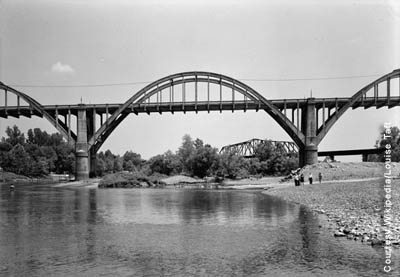White River Concrete Arch Bridge
36 16 02.0 N
92 32 39.0 W

"The graceful arches of the structure seem to fit in with the natural green contours of the surrounding mountains. Standing high on one of the nearby hills and looking down toward the bridge, it looks as if it grew, and was not put there by the hands of man..."
- Editorial in the Baxter Bulletin, Mountain Home, Arkansas, 1930
When this 1,850-foot concrete-arch highway bridge was built on the White River in a remote region of northern Arkansas - prior to the construction of upriver, flood-control dams - flash floods occurred frequently, sometimes causing the water to rise as much as one foot per hour. Construction under these conditions presented a clear danger, so project managers specified both a design and an innovative construction method appropriate to the problem of building across a perilous stretch of unpredictable river.
All materials for the bridge's construction were carried into place by a cable system suspended across the river. The bridge itself was built from a design that called for pre-assembled, latticed-steel ribs - fabricated on shore - that served as both structural reinforcement and as the formwork for pouring concrete, thus minimizing the amount of work that needed to be accomplished over the flowing river.
Facts
- The White River Concrete Arch Bridge comprises five 216-foot arches, each 70 feet high, as well as a single 130-foot arch that crosses a Missouri-Pacific railroad line. The bridge was instrumental in opening a new region of the Ozarks on both sides of the Missouri-Arkansas state line as a major recreation area.
- Even the cofferdams for the bridge's footings were set in place from the project's cable system, allowing workers to blast into solid limestone a few feet below the riverbed. Forms for the bridge's piers, fabricated on shore with reinforcing in place, were then transported into position using the cableway.
- The bridge design was patented in 1912 by the Marsh Engineering Company of Des Moines, Iowa, itself founded in 1896 by James Barney Marsh. His patented design, known as the Marsh Rainbow Arch, was used widely throughout the 1920s and 1930s in Iowa and nearby Midwestern states. The White River bridge is believed to be the largest Marsh Rainbow Arch bridge ever built.
- In the late 1980s, the highway carried by the White River Concrete Arch Bridge was rerouted to a new, $7.6-million bridge. More than a decade later, the Arkansas Highway and Transportation Department, in response to citizen protest, began to consider abandoning plans to dismantle this historic structure and instead commit resources to the bridge's restoration.

